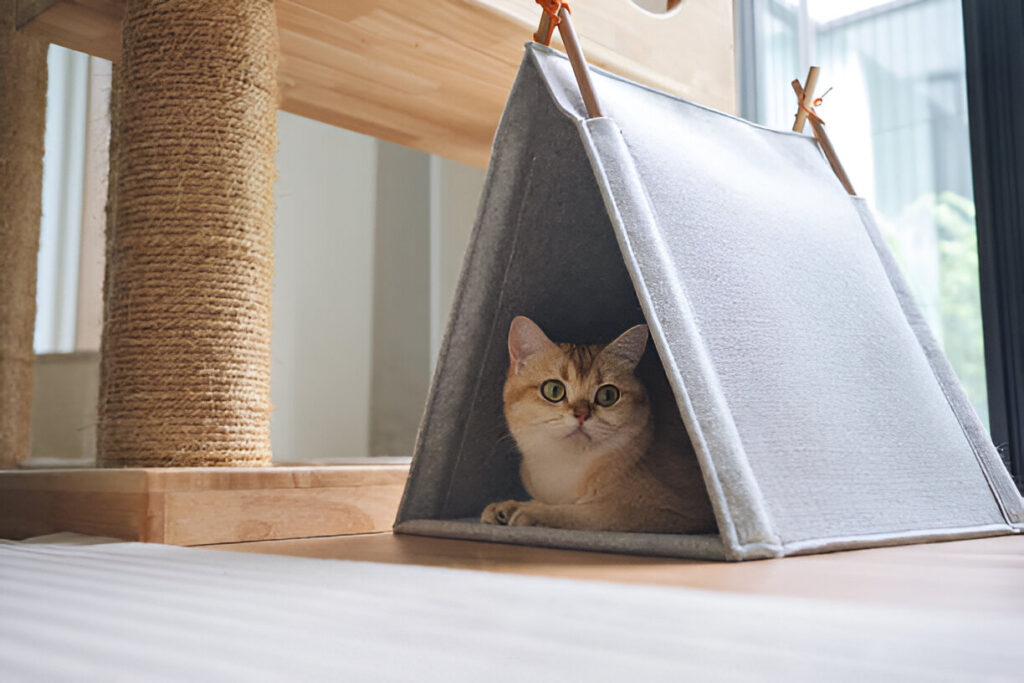Planning Your DIY Cat Climbing Frame
When creating a cat climbing frame, it is important to consider the ideal location, necessary materials, and the design of the layout. These factors help ensure your cat has a safe and enjoyable space.
Choosing the Right Location
Start by finding a spot in your home where your cats spend a lot of time. It’s important that this area has enough space for climbing and playing. Look for walls that are free from obstacles.
Consider safety too. Install the frame away from anything breakable. A quiet corner might work well since cats often like to climb and observe from a safe distance. Make sure it doesn’t block any essential pathways.
Materials and Tools Needed
Gather the right materials before you begin. You’ll likely need sturdy wood for shelves, brackets, and carpet or sisal rug to add grip. Use wall anchors when attaching these to a wall for added stability. This is crucial for preventing any accidents.
For tools, have a drill, screws, a level, and a pencil ready for marking spots. Check the studs on your wall with a stud finder. A tape measure helps in planning the exact placement and sizing of each component.
Designing the Layout
Plan your climbing frame with your pet’s interests in mind. Sketch a rough layout using pencil or painter’s tape to mark where shelves will go. Cats enjoy shelves at different heights, so consider their jump distances.
Arrange cat shelves so they can move smoothly up and down. You might start with a low shelf and gradually increase the height. Adding a sisal rug strip provides good climbing texture. Think creatively about how to create a fun and functional setup for your pets.
Constructing the Base Structure
Building a sturdy base is crucial for your DIY cat climbing frame or cat tree. You’ll want to ensure it supports your cat’s weight and maintains balance without tipping over. Here’s how to start with a solid foundation.
Building the Frame
Begin by deciding on the type of posts to use for your framework. Wooden posts are sturdy and ideal for larger cats. If using wood, attach each post securely to the base using screws. For PVC pipes, a different approach works better: create wooden discs slightly smaller than the pipe’s interior and fix them onto the base. Slide each pipe over its respective disc and secure the connection with self-tapping screws.
Next, choose a base material. Plywood or MDF are popular choices because they’re robust and easy to work with. Cut it to your desired size and sand the edges smooth to prevent splinters. Mark where your posts will attach to the base for easier assembly later on.
Securing the Base
For maximum stability, it’s essential to fix the base to an immovable object, like a wall or floor. Use wall brackets if you’re installing a cat climbing wall. Anchor them into wall studs for security. For free-standing cat trees, consider adding extra weight to the bottom or using larger base dimensions.
Check the stability of your frame by gently shaking it. This ensures everything is tightly secured. If it wobbles, revisit your connections and add more screws or brackets as needed. Finally, you can cover the base with carpet or fabric to match your room decor and provide a comfy surface for your cat.
Adding Vertical Elements
Creating vertical spaces for your cat involves designing interactive areas like climbing walls, cat shelves, and trees. These additions offer your cat a fun and enriching environment.
Installing Climbing Walls
A climbing wall is an exciting edition for your cat’s play area. Materials like wood, carpet, and brackets are needed. Attach multiple levels and vary distances between them to encourage exercise.
Adjust height and angle based on your cat’s agility. Secure everything well to avoid any accidents. Add textures such as rough fabric or sisal ropes for scratching needs. Ensure the wall is sturdy by reinforcing it with strong nails or screws.
Consider painting it fun colors to add a playful touch. Your cat will love exploring new heights!
Mounting Cat Shelves
Cat shelves are a great way to give your feline friends a place to climb and perch. Opt for sturdy materials like wood or metal, capable of supporting your cat’s weight.
Place shelves at different heights and distances to allow your cat to jump between them. You can add a shelf near a window for your cat to enjoy the view easily.
Some shelves have an added benefit of being removable or adjustable, allowing you to change the layout as needed. Be sure to test each shelf by gently applying pressure before allowing your cat on it.
Adding the Cat Tree
Cat trees come with multiple levels, hideouts, and scratching posts that are essential for your cat’s physical activity and mental stimulation. You can either buy a premade one or design one yourself.
When selecting or building a cat tree, ensure it is tall and secure to prevent toppling. Incorporate platforms, tunnels, and dangling toys for added fun. Materials should be durable and claw-friendly like carpet or sisal.
Position the cat tree in a corner or against a wall for added stability. This addition will not only be a favorite hangout spot for your cat but also keep them entertained and exercised.
Incorporating Rest and Play Features
Creating a climbing frame for your cat involves more than just vertical heights. It’s essential to incorporate places for rest and various play features to keep your feline friend entertained. This can include a cozy cat hammock for lounging, scratching posts to satisfy clawing needs, and rope bridges for a sense of adventure.
Placing a Hammock
A cat hammock can become your cat’s favorite resting spot. It’s easy to attach a small hammock between two sturdy points on the frame. Make sure it’s secure and can support your cat’s weight.
Choose soft, durable fabric that your cat will enjoy. Installing it at different heights offers variety and encourages your cat to explore. Check regularly for wear and tear to keep it safe and comfy.
Attaching Scratch Posts
Scratch posts are a must for any cat climbing frame. They help keep your cat’s claws healthy and away from your furniture. To make one, wrap sisal rope around a sturdy post.
Ensure the post is securely attached to the frame. It should be tall enough for your cat to fully stretch. Consider placing multiple posts at various levels to provide options. This keeps your cat engaged and extends the life of the posts.
Hanging Rope Bridges
Rope bridges introduce a playful element. Use strong ropes to connect different parts of the frame. Knot them well to ensure safety. Varying the tension can make the bridges more challenging and fun for your cat.
Position these bridges between platforms at different heights. This encourages climbing and keeps their routine interesting. Regular checks for wear on the ropes can help prevent accidents and ensure your cat enjoys a safe adventure.
Finishing Touches and Safety
Adding the final details to your cat climbing frame makes it both stylish and secure. Ensuring stability and safety will ensure your cat can enjoy its new playground without worries.
Applying the Finishing Materials
It’s time to add those fun and durable materials. Consider wrapping some parts of the frame in sisal rug. Cats love the texture, and it’s perfect for scratching. Use a staple gun or strong adhesive to secure the rug snugly.
You can also paint or stain wooden parts to match your home decor. Make sure to use non-toxic finishes to keep your cat safe. For added flair, attach toys using durable strings or clips that can hold up to your cat’s attention.
Ensuring Stability with Wall Anchors
After building the frame, it’s important to make sure it’s secure. Consider using wall anchors to attach taller parts. These provide extra stability and prevent the frame from toppling. Measure and mark where you want to attach anchors for the best support.
Pre-drill holes for the anchors to avoid splitting the wood. Use a level to make sure everything is straight and even. This step ensures the frame stays firmly in place when your cat leaps or climbs.
Inspecting for Safety
Checking your finished frame for safety keeps your cat happy and healthy. Look for any sharp edges or protruding screws. Smooth these out with sandpaper or cover them with padding. Examine each wall perch to ensure they are steady and free of wobble.
Regularly inspect for any loose parts or wear and tear. Tighten screws and check that all materials used are still in good shape. Doing this regularly ensures your cat’s playground remains a safe space for play and relaxation.



